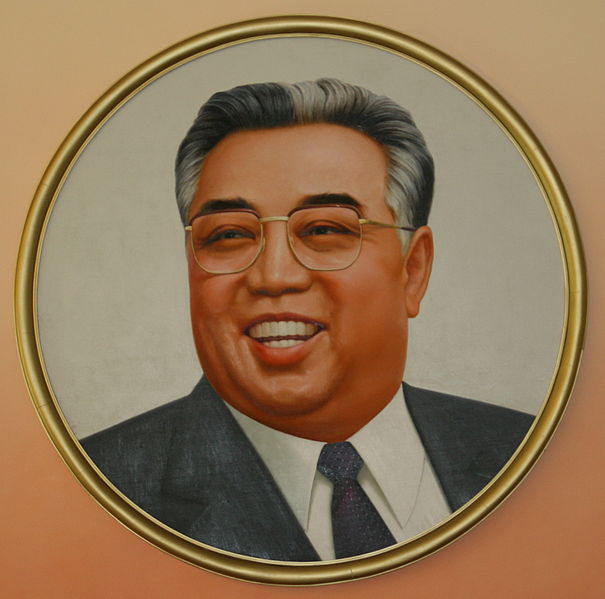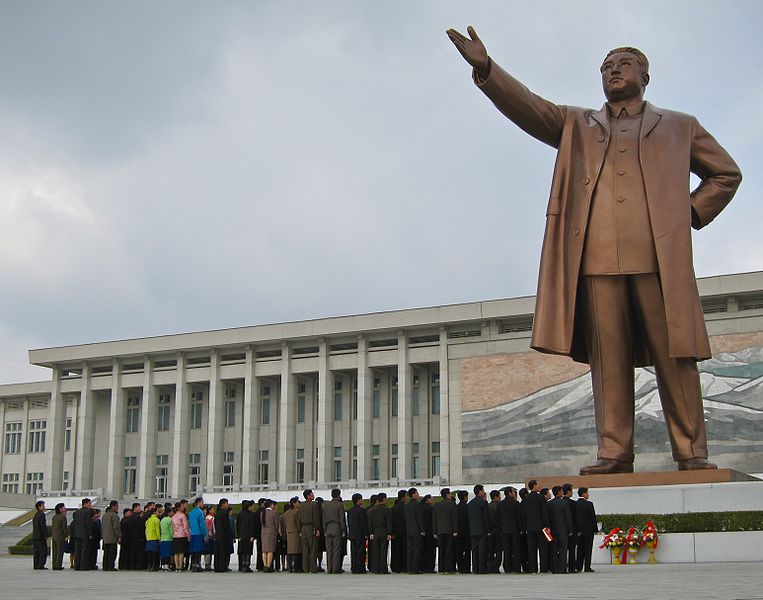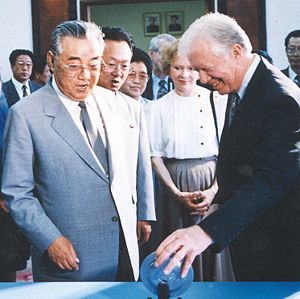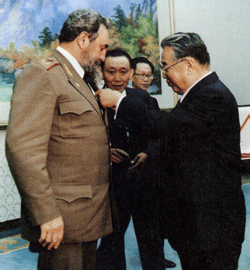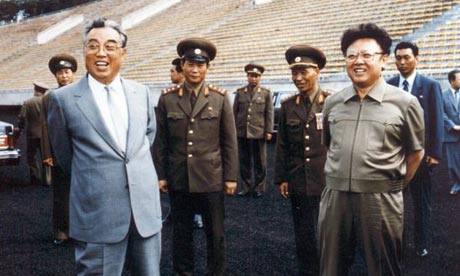<Back to Index>
- Naturalist Étienne Geoffroy Saint-Hilaire, 1772
- Architect Khoca Mimar Sinan Ağa, 1490
- President of North Korea Kim Il-sung, 1912
PAGE SPONSOR
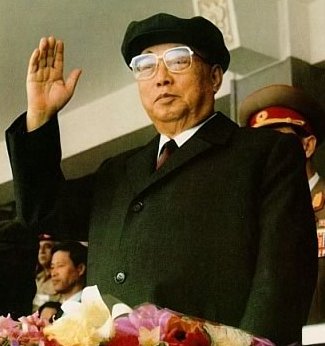
Kim Il-sung (15 April 1912 – 8 July 1994) was a Korean communist, and later Juche, politician who led North Korea from its founding in 1948 until his death in 1994. He held the posts of Prime Minister from 1948 to 1972 and President from 1972 to his death. He was also the General Secretary of the Workers Party of Korea.
During his tenure as leader of North Korea, he ruled the nation with autocratic power and established an all-pervasive cult of personality. From the mid 1960s, he promoted his self-developed Juche variant of communist national organisation. Following his death in 1994, he was succeeded by his son Kim Jong-il. North Korea officially refers to Kim Il-sung as the "Great Leader" (Suryong in Korean 수령) and he is designated in the constitution as the country's "Eternal President". His birthday is a public holiday in North Korea. Much
of the early records of his life come from his own personal accounts
and official North Korean government publications, which often conflict
with independent sources. Nevertheless, there is some consensus on at
least the basic story of his early life, corroborated by witnesses from
the period. Kim was born to Kim Hyŏng-jik and Kang Pan-sŏk, who gave him the name Kim Sŏng-ju, and had two younger brothers, Ch’ŏl-chu and Yŏng-ju. The ancestral seat (pon’gwan) of Kim's family is Chŏnju, North Chŏlla Province,
and what little that is known about the family contends that sometime
around the time of the Korean - Japanese war of 1592 – 98, a direct
ancestor moved north. The claim may be understood in light of the fact
that the early Chosŏn government’s policy of populating the north
resulted in mass resettlement of southern farmers in Phyŏngan and
Hamgyŏng regions in the fifteenth and sixteenth centuries. At any rate,
the majority of the Chŏnju Kim today live in North Korea, and extant
Chŏnju Kim genealogies provide spotty records. The
exact history of Kim's family is somewhat obscure. The family was
neither very poor nor comfortably well-off, but was always a step away
from poverty. Kim was raised in a Presbyterian family; his maternal grandfather was a Protestant minister,
his father had gone to a missionary school and was an elder in the
Presbyterian Church, and both his parents were reportedly very active
in the religious community. Kim was an accomplished church organist. According to the official version, Kim’s family participated in anti-Japanese activities and in 1920 they fled to Manchuria.
The more objective view seems to be that his family settled in
Manchuria like many Koreans at the time to escape famine. Nonetheless,
Kim’s parents apparently did play a minor role in some activist groups,
though whether their cause was missionary, nationalist, or both is
unclear. Kim's father died in 1926, when Kim was fourteen years old. Kim attended Yuwen Middle School in Jilin from 1927 to 1930, where
he rejected the feudal traditions of older generation Koreans and
became interested in Communist ideologies; his formal education ended
when he was arrested and jailed for his subversive activities. At
seventeen, Kim had become the youngest member of an underground Marxist
organization with fewer than twenty members, led by Hŏ So, who belonged
to the South Manchurian Communist Youth Association. The police
discovered the group three weeks after it was formed in 1929, and
jailed Kim for several months. The Communist Party of Korea had been founded in 1925, but had been thrown out of the Comintern in the early 1930s for being too nationalist. In 1931, Kim had joined the Communist Party of China. He joined various anti-Japanese guerrilla groups in northern China, and in 1935 he became a member of the Northeast Anti-Japanese United Army, a guerrilla group led by the Communist Party of China.
Kim was appointed the same year to serve as political commissar for the
3rd detachment of the second division, around 160 soldiers. It was here that Kim met the man who would become his mentor as a Communist, Wei Zhengmin,
Kim’s immediate superior officer, who was serving at the time as
chairman of the Political Committee of the Northeast Anti-Japanese
United Army. Wei reported directly to Kang Sheng, a high ranking party member close to Mao Zedong in Yan'an, until Wei’s death on 8 March 1941. Kim
was appointed commander of the 6th division in 1937, at the age of 24,
controlling a few hundred men in a group that came to be known as “Kim
Il Sung’s division.” It was while he was in command of this division
that he executed a raid on Poch’onbo,
on 4 June. Although Kim’s division only captured a small Japanese held
town just across the Korean border for a few hours, it was nonetheless
considered a military success at this time, when the guerrilla units
had experienced difficulty in capturing any enemy territory. This
accomplishment would grant Kim some measure of fame among Chinese
guerrillas, and North Korean biographies would later exploit it as a
great victory for Korea. Kim was appointed commander of the 2nd
operational region for the 1st Army, but by the end of 1940, he was the
only 1st Army leader still alive. Pursued by Japanese troops, Kim and
what remained of his army escaped by crossing the Amur River into the Soviet Union. Kim was sent to a camp near Khabarovsk, where the Korean Communist guerrillas were retrained by the Soviets. Kim became a Captain in the Soviet Red Army and served in it until the end of World War II. In
later years, Kim would heavily embellish his guerrilla feats in order
to build up his personality cult. He was portrayed as a boy conspirator
who joined the resistance at 14 and had founded a battle ready army at
19. North Korean students are taught that this Kim led army
singlehandedly drove the Japanese off the peninsula. When the Soviet Union declared
war on Japan in August 1945, it fully expected a long, drawn-out
conflict. However, much to Stalin's surprise, the Red Army churned into
Pyongyang with almost no resistance on 15 August. Stalin realized he
needed someone to head a puppet regime. He asked Lavrenty Beria to
recommend possible candidates. Beria met Kim several times before
recommending him to Stalin. It is widely believed that Kim was selected
over several more qualified candidates because he had no ties to the
native Communist movement. Kim arrived in North Korea on 22 August after 26 years in exile. According to Leonid Vassin, an officer with the Soviet MVD,
Kim was essentially "created from zero." For one, his Korean was
marginal at best; he'd only had eight years of formal education, all of
it in Chinese. He needed considerable coaching to read a speech the MVD
prepared for him at a Communist Party congress three days after he
arrived. They also systematically destroyed most of the true leaders of
the resistance who ended up north of the 38th parallel. In
September 1945, Kim was installed by the Soviets as head of the
Provisional People’s Committee. He was not, at this time, the head of
the Communist Party, whose headquarters were in Seoul in
the US-occupied south. During his early years as leader, he assumed a
position of influence largely due to the backing of the Korean
population which was supportive of his fight against Japanese
occupation.
One of Kim’s accomplishments was his establishment of a professional army, the Korean People's Army (KPA)
aligned with the Communists, formed from a cadre of guerrillas and
former soldiers who had gained combat experience in battles against the
Japanese and later Nationalist Chinese troops.
From their ranks, using Soviet advisers and equipment, Kim constructed
a large army skilled in infiltration tactics and guerrilla warfare.
Before the outbreak of the Korean War, Joseph Stalin equipped
the KPA with modern heavy tanks, trucks, artillery, and small arms. Kim
also formed an air force, equipped at first with ex-Soviet
propeller driven fighter and attack aircraft. Later, North Korean pilot
candidates were sent to the Soviet Union and China to train in MiG-15 jet aircraft at secret bases. Although
original plans called for all-Korean elections sponsored by the United
Nations, in May 1948 the South declared statehood as the Republic of Korea,
and the Democratic People's Republic of Korea was proclaimed on 9
September, with Kim as premier. On 12 October, the Soviet Union
declared that Kim's regime was the only lawful government on the
peninsula. The Communist Party merged with the New People's Party to form the Workers Party of North Korea (of which Kim was vice-chairman). In 1949, the Workers Party of North Korea merged with its southern counterpart to become the Workers Party of Korea (WPK) with Kim as party chairman. By 1949, North Korea was a full-fledged Communist dictatorship. All parties and mass organizations were cajoled into the Democratic Front for the Reunification of the Fatherland, ostensibly a popular front but
in reality dominated by the Communists. Around this time, Kim built the
first of many statues of himself and began calling himself "the Great
Leader." Archival material suggests that
the decision was Kim's own initiative rather than a Soviet one.
Evidence suggests that Soviet intelligence, through its espionage sources in the US government and British SIS,
had obtained information on the limitations of US atomic bomb
stockpiles as well as defense program cuts, leading Stalin to conclude
that the Truman administration would not intervene in Korea. The People’s Republic of China acquiesced only reluctantly to the idea of Korean reunification after being told by Kim that Stalin had approved the action, and
did not provide direct military support (other than logistics channels)
until United Nations troops, largely US forces, had nearly reached the Yalu River late
in 1950. North Korean forces captured Seoul and occupied most of the
South, but were soon driven back by the US-led counter attack. North
Korean history emphasizes that the United States had previously invaded
and occupied the South, allegedly with the intention to push further
north and into the Asian continent. Based on these assumptions, it
portrays the KPA sweep over the South as a counter-attack. By
October, UN forces had retaken Seoul and on 19 October captured
P’yŏngyang, forcing Kim and his government to flee north, first to Sinuiju and eventually into China. On
25 October 1950, after sending various warnings of their intent to
intervene if UN forces did not halt their advance, Chinese troops in
the thousands crossed the Yalu River and entered the war as allies of
the KPA. The UN troops were forced to withdraw and Chinese troops
retook P’yŏngyang in December and Seoul in January 1951. In March UN
forces began a new offensive, retaking Seoul. After a series of
offensives and counter-offensives by both sides, followed by a
gruelling period of largely static trench warfare, the front was
stabilized along what eventually became the permanent "Armistice Line" of 27 July 1953. During the stalemate warfare, North Korea was
devastated by US air raids with very few buildings left standing in the
capital and elsewhere in the country. By the time of the armistice,
upwards of 3.5 million Koreans on both sides had died in the
conflict. Restored
as the leader of North Korea, Kim returned to the country after war's
end and immediately embarked on a large reconstruction effort for the
country devastated by the war. He launched a five-year national
economic plan to establish a command economy, with all industry owned by the state and all agriculture collectivised.
The nation was founded on egalitarian principles intent on eliminating
class differences and the economy was based upon the needs of workers
and peasants. The economy was focused on heavy industry and arms
production. Both South and North Korea retained huge armed forces to
defend the 1953 Demilitarized Zone, although no foreign troops were permanently stationed in North Korea. Kim's
hold on power was rather shaky. To strengthen it, he claimed that the
United States deliberately spread diseases among the North Korean
population. While Moscow and Beijing later determined that these
charges were false, they continued to help spread this rumour for many
years to come. He also conducted North Korea's first large-scale purges
in part to scare the people into accepting this false account. Unlike
Stalin's Great Purge, these took place without even the formalities of a trial. Victims often simply disappeared into the growing network of prison camps. During
the late 1950s, Kim was seen as an orthodox Communist leader, and an
enthusiastic satellite of the Soviet Union. His speeches were liberally
sprinkled with praises to Stalin. However, he sided with China during
the Sino-Soviet split, opposing the reforms brought by Nikita Khrushchev,
whom he believed was acting in opposition to Communism. He distanced
himself from the Soviet Union, removing mention of his Red Army career
from official history, and began reforming the country to his own
radical Stalinist tastes. Kim was seen by many in North Korea, and in
some parts elsewhere in the world, as an influential anti-revisionist
leader in the communist movement. In 1956, anti-Kim elements encouraged
by de-Stalinization in the Soviet Union emerged within the Party to
criticize Kim and demand reforms. After
a period of vacillation, Kim instituted a purge, executing some who had
been found guilty of treason and forcing the rest into exile. By
the 1960s, Kim's relationship with the great Communist powers in the
region became difficult. Despite his opposition to de-Stalinization,
Kim never severed his relations with the Soviets, since he found the
Chinese as unreliable allies due to the unstable state of affairs under
Mao, leaving the DPRK somewhere in between the two sides. The Cultural Revolution, however, prompted Kim to side with the Soviets, the decision reinforced by the neo-Stalinist policies of Leonid Brezhnev. This infuriated Mao and the anti-Soviet Red Guards.
As a result, the PRC immediately denounced Kim's leadership, produced
anti-Kim propaganda, and subsequently began reconciliation with the
United States. At the same time he reinstated relations with both Erich Honecker's East Germany and Nicolae Ceauşescu's Romania.
Ceauşescu, in particular, was heavily influenced by Kim's ideology, and
the personality cult that grew around him was very similar to that of
Kim. However, Kim and Albania's Enver Hoxha (another independent minded Stalinist) would remain fierce enemies and relations would remain cold and tense up until Hoxha's death in 1985. At the same time, Kim was establishing an extensive personality cult, and North Koreans began to address him as "Great Leader" (widaehan suryŏng 위대한 수령). Kim developed the policy and ideology of Juche (self-reliance 주체 사상) rather than having North Korea become a Soviet satellite state. In the mid-1960s, Kim became impressed with the efforts of Hồ Chí Minh to
reunify Vietnam through guerilla warfare and thought something similar
might be possible in Korea. Infiltration and subversion efforts were
thus greatly stepped up against US forces and the leadership that they
supported. These efforts culminated in an attempt to storm the Blue House and assassinate President Park Chung-hee. North Korean troops thus took a much more aggressive stance toward US
forces in and around South Korea, engaging US Army troops in
fire-fights along the Demilitarized Zone. The 1968 capture of the crew of the spy ship USS Pueblo was a part of this campaign.
A
new constitution was proclaimed in December 1972, under which Kim
became President of North Korea. In 1980 he had decided that his son Kim Jong-il would
succeed him, and increasingly delegated the running of the government
to him. The Kim family was supported by the army, due to Kim Il-sung’s
revolutionary record and the support of the veteran defense minister, O
Chin-u. At the Sixth Party Congress in October 1980, Kim publicly
designated his son as his successor. From about this time, however, North Korea encountered increasing economic difficulties. The practical effect of Juche was to cut the country off from virtually all foreign trade. The economic reforms of Deng Xiaoping in
China from 1979 onward meant that trade with the moribund economy of
North Korea held decreasing interest for China. The collapse of
communism in Eastern Europe and the Soviet Union, during 1989 – 1991,
completed North Korea's virtual isolation. These events led to mounting
economic difficulties. North
Korea repeatedly predicted that Korea would be re-united before Kim’s
70th birthday in 1982, and there were fears in the West that Kim would
launch a new Korean War. But by this time, the disparity in economic
and military power between the North and the South (where the US
military presence continues) made such a venture impossible. As he aged, starting the late 1970s, Kim developed a growth on the back of his neck which was a calcium deposit.
Its location near his brain and spinal cord made it inoperable. Because
of its unappealing nature, North Korean photographers always shot and
filmed him from the same slight-left angle, which became a difficult
task as the growth reached the size of a baseball. This growth is still visible on his embalmed body. In
early 1994, Kim began investing in nuclear power to offset energy
shortages brought on by economic problems. This was the first of many
"nuclear crises". On 19 May 1994, Kim ordered spent fuel to be unloaded
from the already disputed nuclear research facility in Yongbyon.
Despite repeated chiding from Western nations, Kim continued to conduct
nuclear research and carry on with the uranium enrichment programme. In
June 1994, former President Jimmy Carter travelled to Pyongyang for talks with Kim. To the astonishment of the United States and the International Atomic Energy Agency, Kim agreed to stop his nuclear research program and seemed to be embarking upon a new opening to the West. By
the early 1990s, North Korea was nearly completely isolated from the
outside world, except for limited trade and contacts with China,
Russia, Vietnam and Cuba. Its economy was virtually bankrupt, crippled
by huge expenditures on armaments, with an agricultural sector unable
to feed its population, but state-run North Korean media continued to lionize Kim. On
8 July 1994, at age 82, Kim Il-sung collapsed from a sudden heart
attack. After the heart attack, Kim Jong-il ordered the team of doctors
who were constantly at his father's side to leave, and for the
country's best doctors to be flown in from Pyongyang. After several
hours, the doctors from Pyongyang arrived, and despite their best
efforts to save him, Kim Il-sung died. After the traditional Confucian
Mourning period, his death was declared thirty hours later. Kim
Il-sung's death caused a nationwide mourning crisis, and a ten-day
mourning period was declared by Kim Jong-il. His funeral in Pyongyang
was attended by hundreds of thousands of people from all over North
Korea, many of whom were mourning dramatically (there were reports that
many people committed suicide or were killed in the resulting mass
mourning crushes), weeping and crying Kim Il-sung's name during the
funeral procession. Kim Il-sung's body was placed in a public mausoleum at the Kumsusan Memorial Palace, where his preserved and embalmed body lies under a glass coffin for
viewing purposes. His head rests on a Korean-style pillow and he is
covered by the flag of the Workers Party of Korea. Video of the funeral
at Pyongyang was broadcast on several networks, and can now be found on
various websites. Kim Il-sung married twice. His first wife, Kim Jong-suk, bore him two sons and a daughter. Kim Jong-il is
his oldest son. The other son (Kim Man-il, or Shura Kim) of this
marriage died in 1947 in a swimming accident and his wife Kim Jong-suk
died at the age of 31 while giving birth to a stillborn baby girl. Kim
married Kim Sŏng-ae in 1952, and it is believed he had three children with her: Kim Yŏng-il, Kim Kyŏng-il and Kim Pyong-il. Kim Pyong-il was prominent in Korean politics until he became ambassador to Hungary. Since 1998 he is ambassador to Poland. Kim
was reported to have other illegitimate children, as he was well known
for having numerous affairs and secret relationships. They included Kim Hyŏn-nam (born 1972, head of the Propaganda and Agitation Department of the Workers' Party since 2002) and Chang-hyŏn (born 1971, adopted by Kim Jong-il's sister Kim Kyŏng-hŭi). There are over 500 statues of Kim Il-sung in North Korea. The most prominent are at Kim Il-sung University, Kim Il-sung Stadium, Kim Il-sung Square, Kim Il-sung Bridge and the Immortal Statue of Kim Il-sung. Some statues have been destroyed by explosions or damaged with graffiti. Yeong Saeng ("eternal
life") monuments have been erected throughout the country, each
dedicated to the departed "Eternal Leader", at which citizens are
expected to pay annual tribute on his official birthday or the
commemoration of his death. It
is also traditional that North Korean newly weds, immediately after
their wedding, go to the nearest statue of Kim Il Sung to lay flowers
at his feet. Kim
Il-sung's image is prominent in places associated with public
transportation, hanging at every North Korean train station and airport. It
is also placed prominently at the border crossings between China and
North Korea. His portrait is featured on the front of all recent North Korean won banknotes. Thousands of gifts to Kim Il-sung from foreign leaders are housed in the International Friendship Exhibition. Kim
Il-sung was the author of many works and they are published in books.
His works are published by the Workers' Party of Korea Publishing House
and among them are "Complete Collection of Kim Il Sung's Works" and "Collection of Kim Il Sung's Selected Works". These include new year speeches, and other speeches delivered on
different occasions. Shortly before his death, he also published an
autobiography entitled "With the Century" in 8 volumes. According to official North Korean sources, Kim Il-sung was also the original writer of The Flower Girl, a revolutionary theatrical opera, which was made into a film adaptation in 1972.
